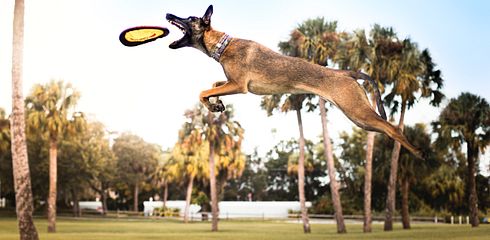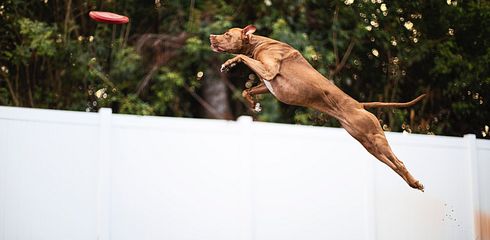Not only hunters face this problem. You may already be a dog owner but are considering getting a second dog. This is generally not a problem, or is it? The acquisition of a second dog comes with many questions and considerations. This article will show you how to introduce two dogs most easily and what to keep in mind.
The First Meeting
Before introducing two dogs for the first time, some basic considerations should be made:
- How does the existing dog behave when encountering other dogs? Does he like to play with them, does he react aggressively, or does he simply ignore them?
- Does the dog get along better with males or females?
- Does he accept larger or smaller dogs as playmates? Or does he prefer dogs of the same size, older or younger dogs?
- Are there specific dogs he cannot get along with at all? Is it an individual aversion, or does it apply to all dogs of a certain breed, coat color, or with other similarities?
It is also important to be clear about your own reasons for acquiring a second dog:
- Do I have enough time to care for my first dog appropriately, or should the second dog take over this task?
- Is my first dog well-trained, or should the second dog compensate for this?
- Can I handle the additional costs and effort of a second dog?
If everything fits, the first dog gets along well with other dogs, and enough time has been planned for training and activities, nothing stands in the way of the first meeting. However, it is essential that two people are present so that each can take care of one dog. Additionally, sufficient time should be planned to attempt the introduction calmly and without stress. Here are some tips for the process:
- Meet in a neutral location that both dogs do not know.
- Take a short walk with each dog alone beforehand to make them as relaxed as possible.
- It is best to let the dogs off-leash, as leashes can promote aggression.
- Watch for early signs of aggression or fear in both dogs.
- If conflicts arise, break off the meeting and wait until the dogs have calmed down.
- If the dogs are relaxed and start to play, let them continue.
- If everything goes well, you can go for a walk together.
Behavior at Home
How to introduce dogs in a shared home is an important question that needs to be clarified in advance. It is crucial to ensure that the home the dogs are coming to is ready to receive them. This means that all items that could cause disputes, such as toys, chew sticks, and food bowls, should be removed. While the first dog is taken for a walk by a family member, the new dog can explore and get used to its new home. When entering the house, it is advisable to closely observe the dogs but not to intervene immediately if there are brief disputes. This is normal, and the first dog has the right to its home initially.
Afterward, each dog should be treated equally and trained consistently. It is important that each dog has its own sleeping and feeding area and that food is given in separate rooms. Until they are fully accustomed to each other, the dogs should not be left alone, and if they must be alone, they should be in separate rooms. It may take several weeks for the dogs to get used to each other and establish a hierarchy. Once this is the case, this hierarchy should be encouraged. It would be wrong to undermine the new hierarchy.
The Human-Dog Relationship
A harmonious relationship between human and dog is essential for every dog owner. It is about communication, understanding, and mutual reliance between human and dog. Here are some tips on how to build a harmonious human-dog relationship: It is important to understand the dog's needs to establish a harmonious relationship. Dogs are social animals and require regular exercise, engagement, and attention. Make sure to give your dog enough time and attention so that he does not feel neglected.
An open communication between human and dog is a must to build a harmonious relationship. Learn to read and understand your dog's body language to better interpret his needs and emotions. At the same time, you should provide your dog with clear communication by setting clear and consistent rules and boundaries. Good training is essential to establish a harmonious relationship between human and dog. Train your dog in a positive and consistent manner. Use rewards to reinforce good behavior and avoid physical punishment for unwanted behavior; instead, focus on negative punishment, such as ignoring the dog.
Dogs need not only physical but also mental stimulation. Give your dog enough time to explore his environment and use his nose. Offer him regular walks, but also mental challenges like learning new tricks or hiding food. Dogs have their own personalities, and it is important to respect this. Do not try to force your dog to do something he does not want or cannot do. Instead, learn to understand his needs and preferences and respond to them.
A loving relationship between human and dog is a vital part of a harmonious relationship. Regularly show your dog love and affection by petting him, giving him attention, and praising him. Build a positive relationship with your dog by considering him part of your family. Overall, a harmonious relationship between human and dog requires time, patience, and consistency. However, if you follow these tips, you can be sure that you will build a close and positive relationship with your dog.
The Right Behavior
If you have dogs and plan to get another dog, you should also know how to respond correctly to your dogs' behavior. A wrong reaction can quickly lead to behavioral issues or a poor relationship between you and your dog. Therefore, it is important that you are familiar with the correct response to your dog's behavior. One of the most important rules is that you should always remain calm and patient. If your dog does something wrong, you should never shout loudly or hit him. Instead, you should calmly show him what he did wrong and how he can do better. Positive reinforcement is an important factor here. If your dog does something well, you should praise and reward him. This way, he will want to repeat the behavior and learn what you expect from him.
It is also important that you do not confuse your dog with human emotions. Dogs cannot understand why you are angry or shouting. If you teach your dog what to do without confusing him, he will learn faster and feel more comfortable. Another important rule is to pay attention to your dog's body language. Dogs primarily communicate through body language, and you should be able to recognize whether your dog is stressed, anxious, or aggressive. If you recognize these signs, you should respond and calm your dog or help him cope with the situation. Your dog's behavior should also always be considered in relation to his breed and individual personality. Some breeds are naturally more dominant or independent than others and may require a different type of training or education. If you know your dog well, you can train him better and understand what he needs to be happy and healthy.




























